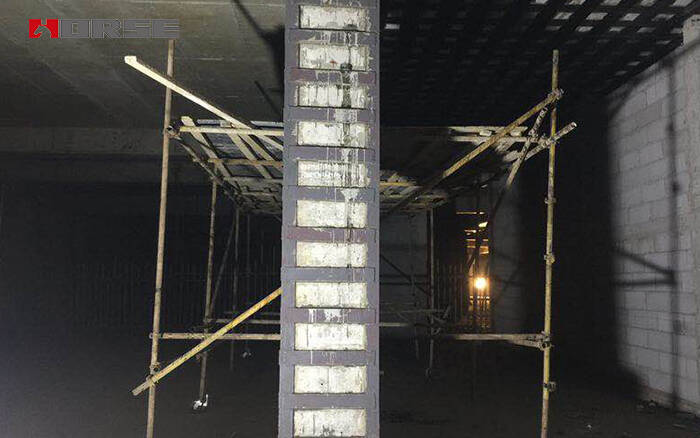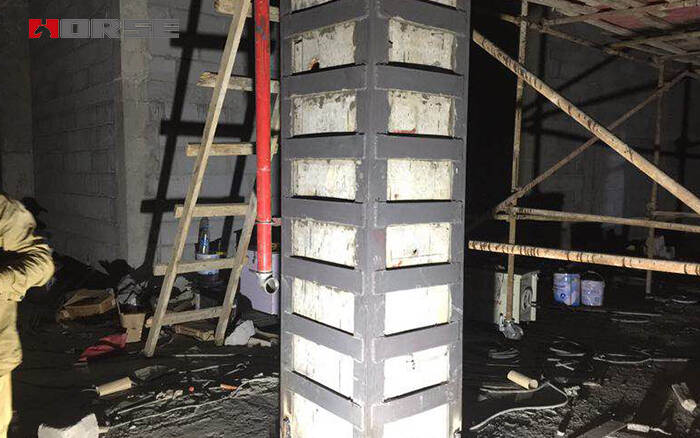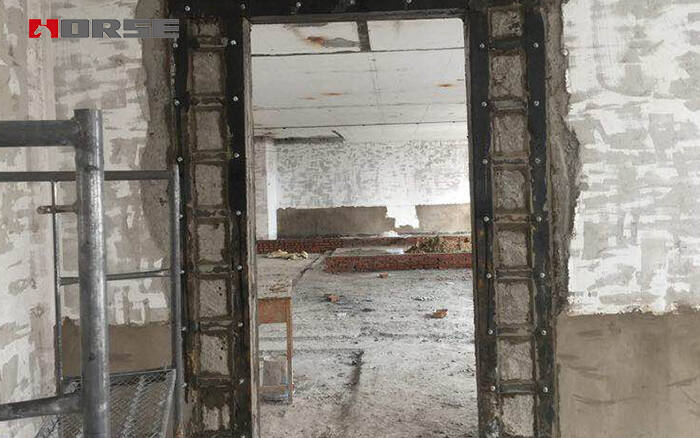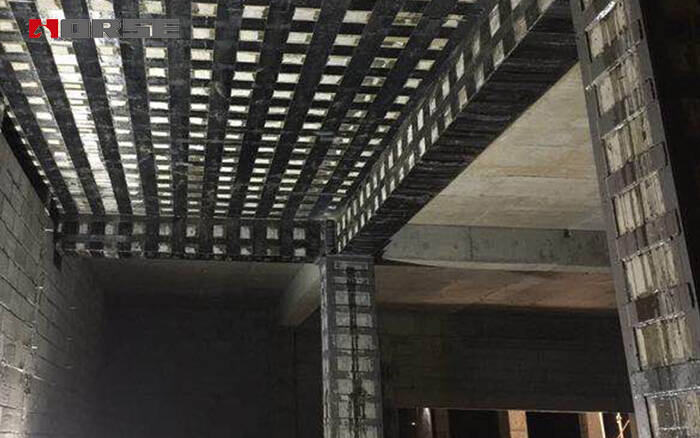Refuerzo de RC mediante placa de acero externa
Adhesivo para placas de acero
El refuerzo de la placa de acero mejora la capacidad portante de la estructura a través de la acción conjunta de la placa de acero del poste y el componente original, y refuerza la resistencia al corte, a los terremotos y la estabilidad, y mejora el estado de tensión.

Descripción general del proyecto
El programa es un proyecto de refuerzo sísmico de edificios, con una superficie total de construcción de 16.892 m² y una estructura de hormigón armado. El refuerzo se centra en muros internos y externos, forjados, vigas y columnas estructurales, y la reparación de grietas en ventanas, aberturas y muros. Tras el refuerzo, su vida útil es de al menos treinta o cuarenta años. La estructura tiene un grado de seguridad dos; la fortificación sísmica es clase B; la intensidad de la fortificación es de 7 grados, primer grupo 0,10 g; las medidas sísmicas son de 8 grados; el componente asísmico es grado tres; la profundidad de congelación es de 0,73 m; la presión básica del viento es de 0,50 kN/m²; la presión básica de la nieve es de 0,35 kN/m²; el control de calidad de la construcción de mampostería es grado B.
Características constructivas del refuerzo de placa de acero adherida
En comparación con otros métodos de refuerzo, el acero estructural adherido presenta numerosas ventajas únicas y un diseño avanzado. Su resistencia de adhesión es alta y su resistencia después del curado es mucho mayor que la del componente original. Presenta buena resistencia al agua y resistencia media, además de buenas propiedades físicas y mecánicas. La tensión en la unión de los componentes remachados y soldados es uniforme, sin concentración de tensiones, y presenta buena resistencia a la fatiga, resistencia al agrietamiento e integridad. Este modelo de utilidad se caracteriza por su tecnología simple, fácil operación, rápida construcción, alta eficiencia, corto plazo de construcción, bajo costo y buenos resultados.

Ámbito de aplicación
El método de refuerzo de acero adherido es aplicable a elementos que soportan cargas estáticas, como flexión, tracción, cortante y otras. El ámbito de aplicación específico es el siguiente:
1) Rotura del punto de soldadura de la barra de acero de refuerzo y refuerzo de la armadura de fugas durante la construcción.
2) La resistencia de la estructura o componente no es suficiente, por lo que se refuerza la resistencia estructural.
3) Refuerzo integral de edificios antiguos y refuerzo sísmico con adición de capas.
4) Se mejora el refuerzo de carga de la viga puente grúa y la viga de grúa colgante.
5) Se refuerza la fractura de la raíz del balcón y la fractura de la viga abdominal delgada.
6) Se mejora la capacidad portante de las columnas para solucionar el problema de la relación de compresión axial de las columnas que excede el refuerzo estándar.
7) Consolidación de la carga del piso.
8) Liang Zhu se reforzó por corrosión química.
9) La corrosión del larguero inferior de la viga del marco está gravemente expuesta al refuerzo.

Principio básico
Utiliza una fuerte adhesión al hormigón y trabaja en conjunto. Aprovecha al máximo la capacidad portante del componente original, mejora la capacidad portante de la estructura mediante la unión de la placa de acero del poste y el componente original, refuerza la resistencia al corte y a los terremotos, y mejora el estado de tensión.
Tecnología de la construcción
1.Preparación de la placa de acero
De acuerdo con los planos de diseño, de acuerdo con el tamaño real de los componentes de hormigón, la placa de acero se corta, se forma y se perfora.
2.Tratamiento superficial de hormigón y placa de acero.2.1 Concrete surface treatmentAccording to the design requirements of the drawings, lay the thread and drill holes on the concrete Primero, se limpia la superficie y luego se entierran los pernos. Para la superficie adhesiva del componente de hormigón original, se sumerge en acetona con un cepillo duro, se limpia el aceite y la suciedad, se enjuaga con agua fría y se lija para eliminar de 2 a 3 mm de espesor hasta que la nueva superficie quede completamente expuesta. Se elimina el polvo con aire comprimido sin aceite y, una vez seca, se limpia con un algodón desengrasado humedecido en acetona.
2.2 Tratamiento superficial de la placa de acero
La superficie de unión de la placa de acero debe desbastarse y tratarse con un tratamiento rugoso. Si la placa no presenta oxidación ni corrosión leve, se puede lijar con chorro de arena, un paño abrasivo o una muela abrasiva plana hasta que aparezca el brillo metálico. Cuanto mayor sea la rugosidad, mejor será la textura del pulido, que deberá ser perpendicular a la dirección de la tensión de la placa de acero. A continuación, limpie con un paño de algodón humedecido en acetona. Si la corrosión de la placa de acero es grave, primero se debe remojar durante 20 minutos con ácido clorhídrico moderado, eliminar la capa de óxido, enjuagar con agua con cal, neutralizar el ácido y, finalmente, utilizar la muela abrasiva plana para desbastar el grano.
3.Descarga de componentes reforzados
Los elementos de refuerzo deben descargarse antes de pegar las placas de acero. Si se utiliza elevación con gato, se debe utilizar una elevación superior multipunto (al menos dos) para la viga que soporta la carga uniforme. Para la viga principal, con la acción de la segunda viga, se debe colocar un gato debajo de cada viga, y el tonelaje superior no debe aparecer en la superficie superior.

4.Aplicación de adhesivo para placas de acero
Una vez preparado el adhesivo, se aplica sobre la superficie de hormigón tratada y la placa de acero. Para que el adhesivo se filtre, se disperse y se adhiera completamente a la superficie, primero se debe aplicar una pequeña cantidad de pegamento, con un grosor de 1 a 3 mm, y el borde central debe ser delgado. A continuación, se fija la placa de acero a la reserva. Posición. Tras pegar la placa de acero, se golpea suavemente con un martillo contra la superficie de la pasta. Si no hay huecos, significa que la placa de acero está bien pegada. De lo contrario, se debe retirar la película y volver a pegarla.
5.Fijo, presurizado
Una vez adherida correctamente la placa de acero, se deben apretar y presurizar inmediatamente los pernos de expansión para que el líquido adhesivo salga por la costura lateral de la placa de acero.
6. Curado
Curado a temperatura ambiente, manteniéndose a 20 grados centígrados, 24 h puede desmontar la abrazadera o el soporte, se puede utilizar la fuerza 3 D, si la temperatura es inferior a 15 C, se debe tomar calentamiento artificial, el uso general de luz infrarroja o aislamiento de calefacción de manta eléctrica, el período de curado no debe tener ninguna alteración en la placa de acero.
7. Prueba
Cuando el acero pegajoso alcance la resistencia de diseño, el personal pertinente será revisado y aceptado.
8.Proteger
Después de la aceptación, la superficie de la placa de acero se une con una capa de malla de alambre de plomo y se aplica una capa protectora de mortero de cemento M15 20.